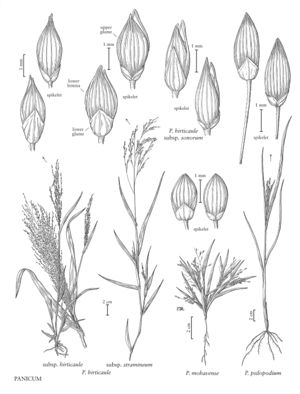familyPoaceae
subfamilyPoaceae subfam. Panicoideae
genusPanicum
subgenusPanicum subg. Panicum
sectionPanicum sect. Panicum
speciesPanicum hirticaule
subspeciesPanicum hirticaule subsp. hirticaule
Panicum hirticaule subsp. hirticaule
Treatment appears in FNA Volume 25. Treatment on page 462.
Culms 11-70 cm tall, usually simple; nodes usually hirsute. Sheaths hirsute, hairs papillose-based; Blades 3-16 mm wide, rounded basally. Panicles erect. Spikelets 1.9-3.3 mm. Lower paleas less than 1/2 as long as the upper florets. 2n = 18, 36.
Discussion
Panicum hirticaule subsp. hirticaule is the most commom of the subspecies, growing throughout the range of the species but occurring more often in arid habitats. It includes P. alatum Zuloaga and Morrone, a recently described species that differs from P. hirticaule subsp. hirticaule by the presence of paired elaiosomes at the base of a slightly stipitate upper floret.
Selected References
None.
Lower Taxa
None.
"decumbent" is not a number."-11-veined" is not declared as a valid unit of measurement for this property.
... more about "Panicum hirticaule subsp. hirticaule"
absent +
common +
absent +
bulliform +
absent +
membranous +
gaping +
apiculate +
puberulent +
acuminate +
absent +
absent +
arising +
single +
sulcate +
cordate-clasping +
cormlike +
rounded +
membranous +
thick +
adaxial +
rounded +
secund +
absent +
sterile +
spikelike +
absent +
sterile +
not developed +
absent +
thick-walled +
arranged +
surrounded +
2;6 +
papillose-based +
sometimes longer +
hirsute +
small green +
simple +
annual +
climbing +
floating +
decumbent +
herbaceous +
not compressed +
narrow +
1/2 +
waisted +
large +
hard +
capillary +
germination +
adjacent +
sometimes longer +
well-developed +
absent +
reduced +
bisexual +
plump +
absent +
herbaceous +
shorter +
shorter or longer +
subtending +
tuberculate +
unequal +
membranous +
equal +
well-developed +
papillose-based +
glabrous +
lacking +
uncinate +
punctate +
Present +
axillary +
thick-walled +
arranged +
surrounded +
thick-walled +
arranged +
surrounded +
thick-walled +
centripetal +
elongated +
spongy +
absent +
distichous +
cauline +
hyaline +
coriaceous +
absent +
membranous +
free +
absent +
inconspicuous +
glabrous +
cuneate +
fleshy +
staminate +
sterile +
reduced +
3-5-veined +
minute +
9-veined +
hyaline +
absent +
separated +
hyaline +
involute +
absent +
hirsute +
absent +
glabrous +
clasping +
keeled +
condensed +
contracted +
diffuse +
subterranean +
erect +
pyramidal +
varying +
absent +
divergent +
appressed +
separating +
thin +
inconspicuous +
evident +
winter +
lunate +
absent +
higher +
thick-walled +
anatomy +
closed +
shorter +
surrounded +
hirsute +
not compressed +
complex +
bisexual +
unisexual +
sessile +
length +
reddish-brown +
attached +
absent +
glabrous +
equaling +
Panicum hirticaule subsp. hirticaule +
Panicum hirticaule +
subspecies +
hyaline +
membranous +
bisexual +
ellipsoid +
7-11-veined +
much longer +
absent +
subequal +
shorter to much +
shiny +
(5)7-15-veined +
rugose +
separated +
absent +
prominent +
scabridulous +
rhizomatous +
perennial +
cespitose +
annual +
herbaceous +
variable +
